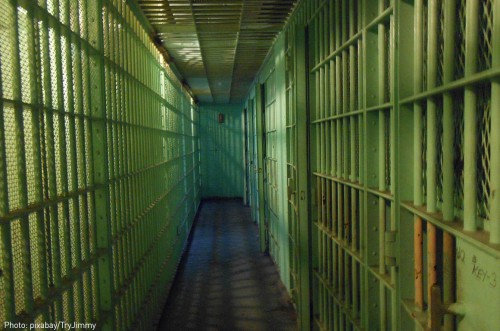
Last week, the San Francisco Chronicle ran the story of “GE,” the 14-year-old unaccompanied minor who has apparently cleared asylum but has still been housed indefinitely at the Yolo County Juvenile Detention Facility despite having no criminal record.
According to their report, unaccompanied minors are housed at two shelters in Solano and Contra Costa counties, but there are also 30 beds reserved for them in the Yolo County juvenile hall, which is the only secure facility in the state.
The Chronicle also cites Holly Cooper, co-director of the Immigration Law Clinic at UC Davis, who is concerned that unaccompanied minors have few legal remedies, and “can find themselves indefinitely detained.” But she said “G.E.’s case is particularly disturbing because he remains locked up despite facing no criminal charges and no pending deportation order.
“We don’t believe that his confinement is constitutionally or legally justified,” she said.
The program expanded from 15 beds to 30 beds in Yolo County in 2015. On October 13, 2015, the Yolo County Board of Supervisors was asked to approve an amendment to the US Department of Health and Human Services, Office of Refugee Resettlement (ORR) grant in the amount of $2,797,229 for the period of October 1, 2015 through September 30, 2016.
The amendment granted 30 beds for unaccompanied children (UC) “that are referred from ORR to Yolo County pending reunification with families or sponsors located inside or outside the United States. By accepting this grant, Yolo County agrees to accept UCs that pose a danger to their self or others or has been charged with having committed a criminal offense.”
Victoria Blacksmith, the Supervising Detention Officer, in October 2016 gave a presentation to the Yolo County Board of Supervisors, which had been receiving funds in the ORR program since 2008. At the time, the Probation Department was seeking an additional three-year grant through 2019 that would maintain the existing level of service.
Ms. Blacksmith told the Board that Yolo County had one of three secure detention facilities in the nation for the ORR program.
She made it clear that these were youth with behavioral issues that are a risk to self, but also those that have disclosed criminal history. These are a small portion of the program – those with adjudications or pending adjudications in the US.
They deal with roughly 75 per year, or around 300 referrals out of hundreds of thousands that go through the ORR program overall.
Ms. Blacksmith also clarified that these individuals must have “serious charges.” She said, “We are not going to a get a youth with petty theft charges. Most of these charges are serious in nature.” She said they range from assaults to sexually inappropriate behavior to gang behavior.
What will happen is that the youth will be arrested for a charge, and the arresting agency flags the youths who commit serious crimes while in the U.S. who are also undocumented. They can also have significant history in the country of origin.
She said even if they were not undocumented, they still would be housed in a secure facility because of their acts.
That leads to a critical question as to how GE ended up at this facility, and unfortunately County Public Information Officer (PIO) Beth Gabor told the Chronicle that “the county’s contract with the federal government prohibits local officials from discussing specific cases.”
It appears that the case of GE is not alone. The Vanguard received a copy of declarations filed in a case before the Ninth Circuit Court of Appeal last August. It details a Guatemalan teenager with a similar background to GE.
The individual, not identified by name, wrote: “They have also not given me any explanation why they transferred me to another detention center for delinquents like Yolo, instead of a place like Southwest Key. I never had any problems with the other detainees or with those in charge of Southwest key.
“In Yolo, we live in a real prison. The food, the program, the life, the routine: everything is a penitentiary. They treat us badly, like delinquents. The entire time, we live locked up. They don’t grab us to go to the park, the library, or anywhere normal. They lock us up in the cells every night, to sleep on benches made out of cement with mattresses.”
The individual indicated that they have “never consulted with a lawyer.”
In a May 26, 2016, letter from the Center for Human Rights and Constitutional Law, it cites a provision that “minors shall not be subjected to corporal punishment, humiliation, mental abuse, or punitive interference with the daily functions of living …”
In violation of the foregoing, on or about May 20, 2016, at approximately 7:00 a.m., “defendants tightly shackled fifteen-year-old class member, causing him physical pain, humiliation, and severe emotional distress, and continued him in shackles during transport him to San Francisco, California, where he was to appear for an interview on his application for asylum.
“The shackles bound the insides of (his) wrists to each other and then tightly attached the wrists to a binding around his waist and then connected to bindings around his ankles. Notwithstanding that the asylum interview had been transferred to a secure federal building – the sixth floor of 630 Sansome Street in San Francisco, California—defendants refused to unshackle class member for his asylum interview, thereby prejudicing his right to a fair, child-appropriate adjudication of his asylum claim.
“Defendants thereafter continued class member in shackles while transporting him in a secure vehicle—a lone child accompanied by two guards—back to Yolo County Juvenile Hall,” they letter continued. “At no time did class member exhibit imminent escape behavior, make violent threats, or demonstrate violent behavior. At no time did Yolo County Juvenile Hall or ORR make an individualized determination that class member posed a high risk of violence or escape if unrestrained.”
They also claim, “Defendants have failed to make good faith efforts to reunify class member with his mother, but have instead refused to release him to her custody. Defendants’ continuing to detain class member is required neither to secure his timely appearance nor to ensure his safety or that of others.”
In another case filed over the summer, attorneys Holly Cooper and Carter White, representing “PA,” a minor, claim that PA has been detained for 26 months.
They write, “Despite his vulnerabilities, P.A. is detained alongside juvenile delinquents in an unsafe, traumatizing environment. P.A. is frequently locked down in a 10 foot by 15 foot cell for the majority of the day due to lack of sufficient jail staff.”
They note the deplorable and abusive conditions in the facility including having “witnessed guards performing oral sex in front of an entire pod of detained children” as well frequent assaults and witnessing children attempt suicide.
They write, “ORR’s detention of P.A. is predicated on secret evidence or evidence that is the fruit of an unlawful interrogation and only underscores the need for judicial oversight and a fair custody hearing. P.A.’s alleged confession to the immigration authorities in July 2014 serves as the primary basis of his detention. Yet ORR has never produced P.A.’s actual confession from July 2014 or any written document from ICE memorializing this interrogation.”
PA was originally apprehended in June 29 by the Border Patrol, having crossed the border without permission. He was accused of “writing graffiti on the wall.” The detective threatened him with prison time but agreed to release him to his mother if he confessed to (redacted).
Despite redactions, PA appears to have been diagnosed with some sort of trauma – in particular, the doctor “found that raised voices are extremely distressing to P.A. and worsen his reality testing.”
The reviewing psychologist found “[P.A.] would be no risk to anyone in a normal uncontrolled environment.” However, “the release was also denied because of his confessions, even though he had retracted them and stated he was coerced during the interrogations.”
Finally, a KQED report from last April 2016, found that “Hundreds of Migrant Teens Are Being Held Indefinitely in Locked Detention.”
They cited the case of “Pablo,” held in Woodland, “Pablo has been held in immigration custody for more than 21 months. He had just turned 15 when he left El Salvador in the hope of finding a safe haven with his mother in California. He made it across the Rio Grande but wound up in the hands of the Border Patrol. That was in June of 2014. He’s been locked up ever since.”
They note, “The vast majority of those kids spend about a month in a licensed ORR-funded shelter, and then they’re placed with a relative or another sponsor while they await their day in immigration court. But a small fraction — roughly 500 to 700 in any given year — are placed in jail-like settings: locked group homes or juvenile detention facilities, as Pablo has been. Those kids are held for two to three months, on average, but, like Pablo, some are detained much longer. Advocates say they become practically invisible.”
Holly Cooper told KQED that the problem here is “that ORR makes decisions at internal meetings about where children are placed and whether they’re released. And ORR doesn’t recognize courts as a place where children can challenge their detention.”
Pablo, like many others, has not been charged with a crime, but has been jailed indefinitely.
“Without any judicial or third-party oversight, ORR is both the jailer and the person who decides whether the kid is getting out,” Ms. Cooper told KQED. “That’s a really dangerous power dynamic that is developing.”
KQED reports: “The ‘secure’ and ‘staff-secure’ lockups may indeed be the right placement for some children. But Cooper and other lawyers say there’s no way to know without an open proceeding. They note that adults in immigration custody have more access to due process, because they have the right to go before an immigration judge to contest their detention and request release on bond. Children do not.”
In a brief filed Friday for the case before the Ninth Circuit Court, by multiple civil and children’s rights organization, they note the potential harm suffered by children in these facilities.
They write, “It is also well understood in the juvenile justice context that institutional placements have harmful effects on youth and should be used only as a last resort when necessary because a child is a danger to himself or others or is a flight risk.”
They argue that the concerns are magnified for immigration children who are “likely to have suffered serious trauma, both in their country of origin and during or after their journey to the United States and their apprehension by immigration authorities. Because children who have been previously traumatized are especially vulnerable to the negative effects of institutional care.”
The American Academy of Pediatrics has expressed grave concern about the detention of immigrant children. They write: “Children and mothers from Central America who have crossed the border to enter the United States have high rates of exposure to trauma in the form of threat of death, physical and sexual abuse, and exploitation that leave serious physical and psychological scars.
“The act of detention or incarceration itself is associated with poorer health outcomes, higher rates of psychological distress, and suicidality making the situation for already vulnerable women and children even worse.
“For children, exposure to early adverse experiences, often referred to as toxic stress, has long-term consequences … [including] measurable effects in his or her developmental trajectory, with lifelong consequences for educational achievement, economic productivity, health status, and longevity.”
On Tuesday, activists will protest the detention of GE. They are asking for the ORR “to set a prompt release date so this child who has been through so much can begin the path to a normal life.”
“A 14-year-old should be thinking about homework and friends, not about how to spend a future alone in a cell. We understand the need to provide suitable care, but adding further incarceration to the trauma this youth has experienced is not the care he needs,” said Seth Sanders, an organizer with Indivisible Yolo.
While some have presented GE’s case as unique – it may not be. The Board of Supervisors was told that the detentions were reserved only for those who are serious threats to themselves or others, but authorities seem to unable to verify that this is in the fact the practice.
—David M. Greenwald reporting






Is the graphic a picture of the facility in question?
No. If you click on the KQED article in the link there they have some photos
Thanks…
Seems that Yolo County has a lot of explaining to do, related to the ongoing detention and treatment of at juvenile immigrants in its care. Keep up the good work David.
Why?
ORR (the Feds) are in charge of ‘detention’… YC is letting them use excess capacity… would you rather have ORR detain them in Susanville in an old wing of the State Prison? Looking at David’s graphic, there are probably a lot worse places than the YC facility to house them (see KQED) cite)… YC is not detaining him… they’re housing and feeding him… perhaps you meant ORR has some explaining to do…
I would say because some of the conduct described was conduct by Yolo County sheriff’s who run the jail. Also, the BOS approved the contract.
Not to mention, where the oversight. It was a county official who gave the staff presentation described that said that the only people housed there are individuals with serious criminal allegations – that’s clearly not true and Yolo should have known it.
ok… and if the BOS had not approved the contract, would not the juveniles be detained elsewhere?
Yes. But there are two different issues here – one is the program ORR and the other is the specific conditions of the jail. You are correct that if not in Yolo, someone else would house them – but that’s not the end of the story.
The solution is not to stop the housing of these kids from Yolo County, but to speed the resolution of their cases, push to require legal representation, and to force ORR to identify homes where these kids can be placed once their status is resolved. It may or may not help to actually charge the youth with the violation that lands them into detention at the Hall. Once the youth is charged, that has to be addressed by the Court in the County where the crime was committed, just further complicating their case.
The question remains – if a youth comes to the U.S., with no family at all, where does he live and who pays for it?
Sharla – I would say the answer is a non-secure facility. I don’t understand why the use of a non-secure facility for individuals who do not seem to fit the profile as was described in the fall.
Where is there a non-secure facility? What does that exactly mean?
As I read it in the report – Yolo County has the only secure facility in the state and only one of three in the nation. Solano and Contra Costa Counties have non-secure facilities.
You mean a facility like Families First?
That was a scandal, to be sure. Witnessed 3 ‘counselors’ body tackle a kid on the bikepath on Fifth Street… kid had a bloody nose and was “pinned”… I called PD, went back and told the counselors that I had done so, and they didn’t blink an eye. One used threatening language to me, so walked off, hoping PD would respond quickly.
[two of them had a 50-100 lb advantage over me, had it come to that…]
These are not kids from Yolo – they are being placed in Yolo.
Yes, I meant to say “in Yolo, ” not from Yolo.
The Chronicle reports that the boy may be released in the coming week.
http://www.sfchronicle.com/bayarea/article/Honduran-refugee-14-may-be-freed-soon-from-Yolo-10996650.php
David, Yolo County does not have a non-secure detention facility, so children were placed far away in boot camps and group homes far away from family. There was talk of remodeling one of the in-used pods at the Hall into a group living space, where the kids could attend regular school, hold jobs, attend community activities, etc. in a structured and more monitored environment. The space would require extensive re-modeling to change the jail- like feel to more of a dorm and provide a front door entrance that would allow the kids to come and go. Then there would need a budget to hire counselors and other staff. I don’t know where this is at or if they are still looking at this.
Sharla-
To quote the late great Tony Benn “if you can find money to kill people, you can find money to help people”. It’s clear to me that this is a prime example of the broken immigration system. From a moral perspective there is no reason why this kid should have ever been locked up for any significant length of time, especially when he got refugee status. If the Sheriff can find money in the budget for another armored vehicle, then I think he can find room in the budget for a proper environment for these kids.
Yes, our immigration system is not equiped to deal with 13 year olds who illegally enter the U.S. with severe mental trauma, prone to act out violently, and no where to live, no family or sponsor to care for them. I would say that we also too often fail kids who are born in the U.S., have family, and access to other resources too. Rather than mouth broad declarations of outrage, focus your attention on Trump’s plans to make kids lives even worse – healthcare, education, clean water, clean air, etc. The good news is that this boy is not being deported back to his abusive parents and it looks like placement in a more suitable living situation is in the works.
The bad news is he’s been indefinitely held in a jail where kids are abusing other kids and guards are abusing kids if I’m reading these reports right.
Well, this action is by no means the ends of anything Sharla, but a beginning. This is an actionable, local goal that we can achieve that will fight the Trump agenda. We plan on tying everything together at this protest. It’s very important we create an intersectional, powerful and diverse movement, and this is the start. I’m very proud of the work Indivisible Yolo has done. They have come far very fast, and ought to be commended for taking action.
Ahhh… sounds like it’s more of a “message” to the Sheriff (do you realize how little money would be needed to acquire/maintain the MRAP? Sounds like mils on the dollar compared to new facility or re-do on one pod), and a “fight the Trump agenda”, than genuine care for the children…
[What’s the aural equivalent of “optics”?]
The contract with ORR started during Obama’s years, so not really a result of Trump’s agenda. The community has given little concern about the conditions in the Hall or how long kids have been held there up to now. It is more out of sight, out of mind with a citizen oversight Commission that tends to rubber stamp approval of everything Juvenile Probation and the Hall does. I welcome the immediate pressure and attention this case has brought to bear, but I know that people tend to just wander away when something more exciting happens. To me, Indivisible is new and is looking for a local issue to latch onto to galvanize its membership. This may be a good one that could actually force change, but people need to take time to educate themselves and make sure their demands are practical. No MRAP doesn’t mean a foster home. The two are not connected.
In fairness, the public really didn’t know about this until the Chronicle came out with an article, although people like Holly Cooper have been trying to sound the alrm on this for a few years now.
Come on Sharla, you need to get with the program. Facts don’t matter anymore, everything is Trump’s fault whether it actually is or isn’t.
I find your comment ironic.
I found your comment above ironic too.